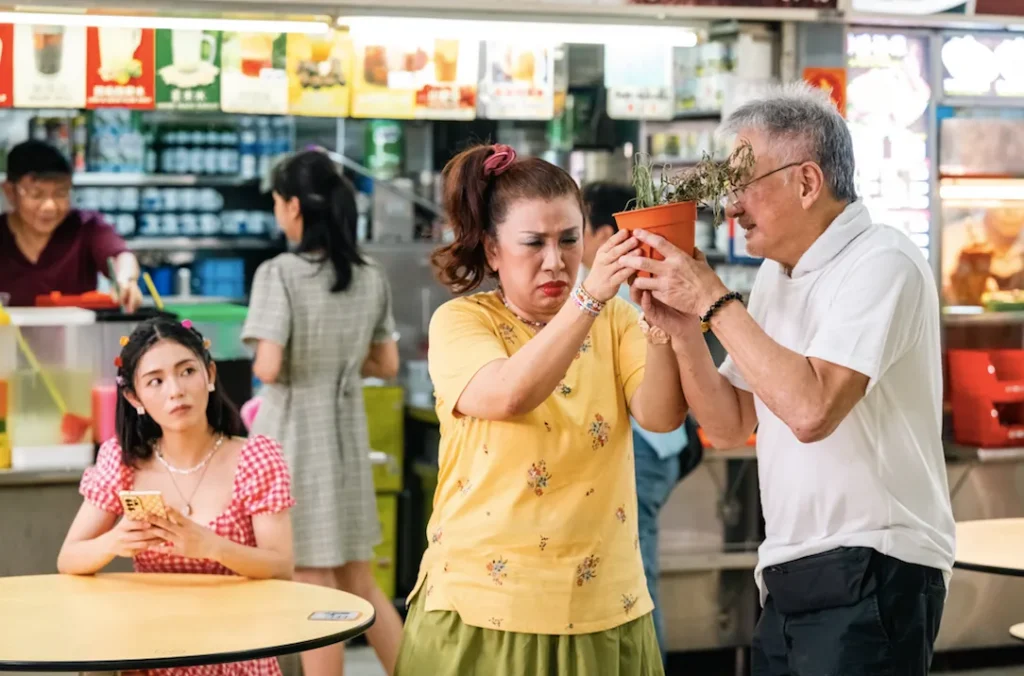
Reviewed by Darryl Goh
Even though Singapore’s hawker food is widely beloved and part of the quintessential local diet, no film has ever featured hawker culture centre stage until King of Hawkers, which was released in February 2024—six decades since pioneer hawkers cooked their way to our hearts.
Director Kelvin Sng said he was inspired to make the film after hawker culture was recognised by UNESCO as an intangible cultural heritage. Wanting to showcase this uniquely Singaporean cuisine to a global audience, Sng is looking to release the film outside Asia, after securing distribution partners in Malaysia and the Philippines.
“My motto is ‘stay local, go global’. I don’t try too hard to create content that is not part of my growing up or my own experience,” he said, adding that his film should resonate with audiences abroad because of its relatable narrative.
“At the end of the day, we are telling a universal story about family, redemption and the human condition, just through the eyes of hawker culture,” he said.
The film follows Zhang Nala (Dawn Yeoh) as she returns to Singapore after a divorce to man her mother’s (Liu Ling Ling) failing bak chor mee stall. This draws the ire of some of her fellow hawkers, led by Liu Derong (Hugo Ng), a headstrong grandfather who sells Singapore’s best chilli crab. When an award-winning Hong Kong masterchef (Moses Cheng) challenges the hawker centre to a cooking duel, the competition descends into dirty tricks and backstabbing as the reputation of Singapore’s hawker food is threatened.

Film still from King of Hawkers (Photo credit: mm2 Entertainment)
Sng dishes on the cast’s cooking skills and his food recommendations at Sims Vista Market and Food Centre, where the hawker scenes were shot.
There are so many hawker foods to choose from. Why feature bak chor mee instead of a dish that is more famous like chicken rice?
We shortlisted about 50 different hawker dishes from Singapore. For the final five that made it to the film (bak chor mee, chilli crab, satay, thosai and bak kut teh), we tried to go for a diverse but classic mix.
Chef John See, the film’s food director, said there was nothing much to film for chicken rice—just steam, chop and that’s it. You can’t do stunts here and there, which was why I shortlisted bak chor mee. The dish was more appealing in terms of the ingredients and the way we could creatively match them with the female protagonist.

Film still from King of Hawkers (Photo credit: mm2 Entertainment)
Did the cast members who played hawkers learn how to cook dishes for the film?
Yes, these actors went through training about two weeks before filming started. We did not get any hand model or substitute; all the cooking shots came from the cast.
Some of them got hurt during filming. Moses was cut badly by the crab while he was chopping it, but because I didn’t say cut, he continued like he was the 厨神 (god of cookery). I really admire and salute these actors for their professionalism.
I also got to try Dawn’s bak chor mee and chilli crab from Hugo and Moses, which were very good. As they were trained and monitored by Chef John, the dishes couldn’t really go wrong. I got to eat bak chor mee so often because Dawn would always offer me until I got sick of it!
Based on recent reports of Mimi Chu wanting to retire, was it hard to convince her to be part of the film?
It wasn’t easy. We told her we only needed two days of her schedule and did not have to worry because most of the dialogue would be in Cantonese, which she is comfortable speaking. Her role also didn’t require her to have emotional outbursts; she just had to look stern all the time.
We told her that Hugo and other Hong Kong-based actors will be in the film as well, so it wouldn’t be a standalone appearance from her. These were the considerations that convinced her to come on board because she wasn’t really keen initially.

Mimi Chu in King of Hawkers (Photo credit: mm2 Entertainment)
The last time we see Liu Derong in the film is during the hospital scene. Does his story end there or were there scenes that did not make it to the final cut?
The original cut of the film was three and a half hours, which was a surprise to me because my script was only 126 pages. Initially, I tried to split the film into two parts but my producer said part one would be too slow since the story was not crafted as a two-parter.
So the final cut that you see is two hours. I received a lot of feedback like “what happened to Liu Derong? Why is there no closure? The hospital scene was so dramatic but in the end nothing happened, we felt cheated!”
We did shoot a scene to conclude Liu Derong’s storyline, but it was cut. It was an emotional scene and even the actors were asking me why, of all the scenes, I had to delete it. In hindsight, I shouldn’t have been influenced by my editor who said this scene could be taken out.
At some point, probably next year, I will be releasing the three and a half hour director’s cut of the film, the way that it’s meant to be seen.
After filming at Sims Vista Market and Food Centre for three weeks, what are your dish recommendations for first-time visitors?
First off, I must say this hawker centre is a hidden gem. When I told others about this place, they were like “Geylang got hawker centre meh?” There’s a lot of good food there that only insiders know.
You must try the wonton mee which is very famous. Talking about it makes me hungry. Get your kopi from Heng Heng Coffee Stall. It was the only stall board that we did not remove for the movie. Their coffee is very special—a lot of patrons were angry with us because they could not drink Heng Heng’s coffee for three weeks and said it was torture. So these two are highly recommended!
King of Hawkers is now playing in cinemas.
About the Author: Darryl obsesses over creative details in media, from films to brand campaigns. He writes about the local creative scene and makes art inspired by local news stories. These personal projects can be tiring at times, but they also make him feel truly alive.
Click Here For More Film Reviews
Do you love writing? Send us a film review and we will feature it on our website. Any film that people can see in the theater or online. Email to: media@scape.sg
This review is also published on Singapore Film Society as part of *SCAPE’s Film Critics Lab: A Writing Mentorship Programme.
